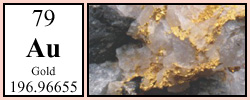
Gold
is a soft yellow metal element with the symbol Au and an atomic number of 79. It is slightly softer than silver
with a beautiful yellow tone. Gold is a good conductor of heat and
electricity and reflects infrared radiation strongly.
Gold won't tarnish, rust, or corrode. Gold is typically found in veins and deposits
within hard rock formations.
Gold is the most malleable and ductile of all metals; a single gram can be beaten into a sheet of 1 square meter,
or an ounce into 300 square feet. Gold readily creates alloys with many other
metals. These alloys can be produced to modify the hardness and other
metallurgical properties, to control melting point or to create different colors.
Gold Jewelry
Because of the softness of pure (24k) gold, it is usually alloyed with base metals such as silver, copper,
nickel, and zink for use in jewelry to give it strength and durability.
Karatage, noted by a number followed by "k" indicates purity, or how much of the metal in a piece of
jewelry is gold. Karatage is expressed in 24ths, making 24k gold 100% gold.
The color of gold is determined by two factors: the type of metal alloys included in it; and the
percentage of each metal alloy.
| Gold Karatage Chart |
% Gold |
24 karat
|
100% gold
Too soft for jewelry
|
22 karat
|
91.7% gold
Very soft
|
18 karat
|
75% gold
Recommended for fine jewelry
|
14 karat
|
58.3% gold
Recommended for jewelry
|
12 karat
|
50% gold
Uncommon karatage
|
10 karat
|
41.7% gold
The legal limit considered real
gold in the United States
|
Yellow Gold
In jewelry at BeadifulBABY, you'll find 22k, 18k, and 14k yellow, white, and rose gold. 18k gold contains more precious metal than
14k gold. It is composed of 75% gold, which is alloyed with other metals
(usually copper and silver) to make it strong enough to
withstand every-day wear. Because 14k gold is composed of only 58.3% gold, and 41.7% other metals that
give it strength, its gold color is not as rich as 18k gold. 14k gold is most commonly found in cases
where strength is most important, like in earring backs and bracelet clasps.
White Gold
The term white gold is used very loosely in the jewelry industry to describe karat gold alloys with a
whitish hue. White gold is an alloy of gold and at least one white metal, usually nickel,
manganese, or palladium. To enhance the whiteness, most white gold is plated
with rhodium, a shiny, white metal which is extremely hard. Depending on the amount of wear
to a piece of jewelry, over time this rhodium plating may wear off, revealing the original
metal color. Re-plating is a simple process that can be done to restore your jewelry's
whiteness if needed.
Rose Gold
Rose gold is a gold and copper alloy. It gets it's color from a larger proportion of copper in the metal alloy. This gives
the gold a beautiful pinkish rose color. Although the names are often used
interchangeably, the difference between red, rose, and pink gold is the copper
content – the higher the copper content, the stronger the red coloration.